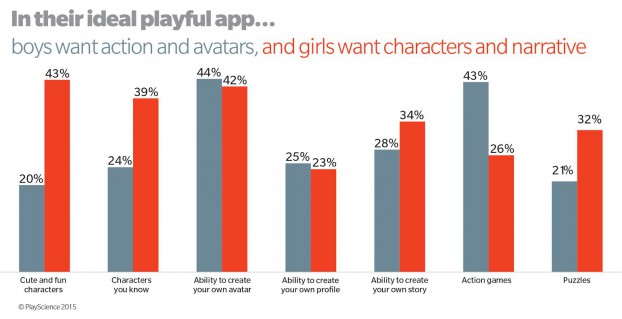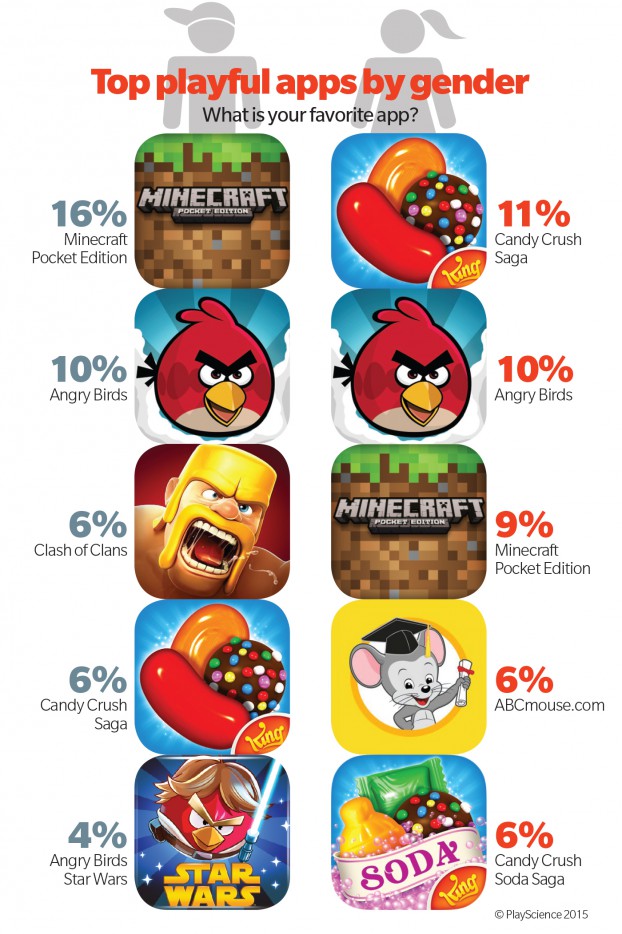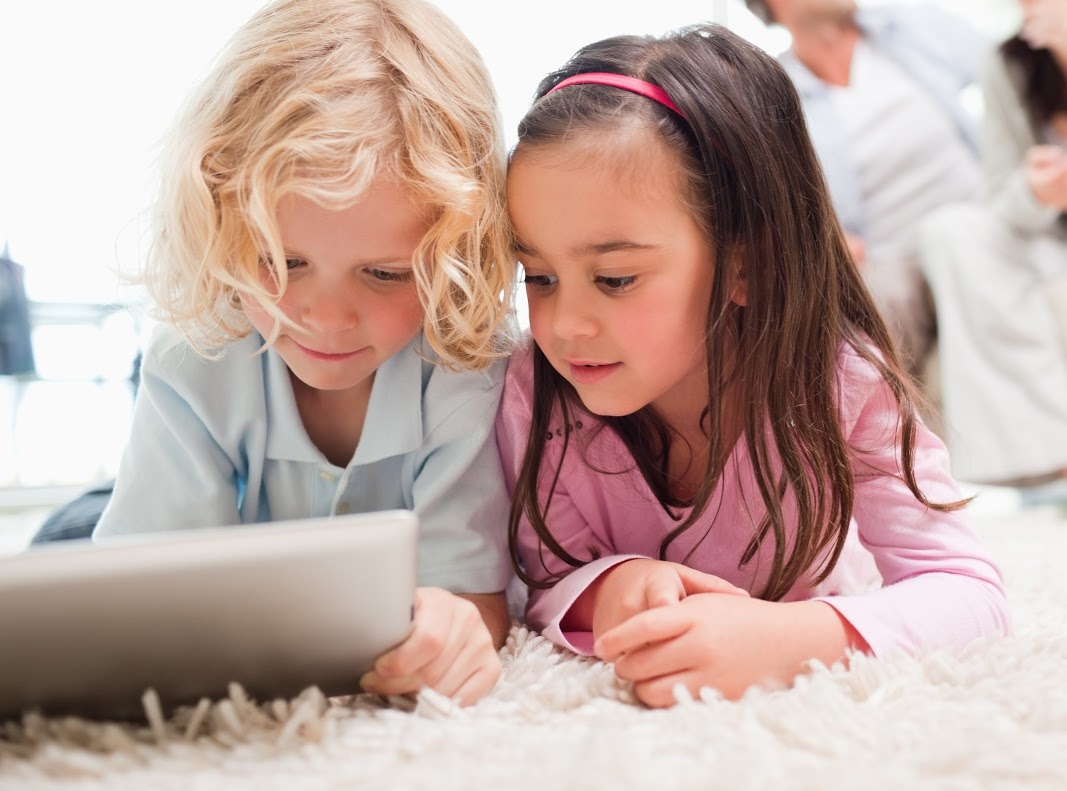We’ve been conditioned to accept that men may be from Mars and women from Venus—but when it comes to boys, girls and playtime, labels are far from universal.
This past summer, American retail giant Target made headlines with its plans to remove gender-based signs from its stores, citing a shift in shopping preferences and consumer needs. Similar changes have been implemented by several global retailers like Toys ‘R’ Us in the UK. Yet gendered toys, apps and digital platforms still abound, as do a number of gender discrepancies, particularly within the digital spectrum. With the help of New York-based innovation and development company PlayScience and the Casual Games Association, new research is unearthing some surprising gender perceptions— and causing the formation of new ones at the same time.
For CEO Alison Bryant and her team at PlayScience, what started off as a basic study on kids’ app preferences quickly spiraled into something much more disruptive.
“Kids categories are a mystery when it comes to digital,” says Bryant. “But things got a lot more interesting than simply finding out if children are playing Angry Birds or not.”
Among the discoveries made in Kid Appeal, which surveyed more than 1,350 American kids ages six to 14 and their parents, is the fact that parents are 30% more likely to let their sons choose their own apps versus their daughters. Parents are also nearly 10% more likely to want apps that focus on academic skills for their daughters, and they are 13% more likely to pay for an app for their sons.
According to PlayScience’s spring 2015 study, Parents and Platform Perceptions, platforms are also getting the preferential treatment, as parents are more likely to opt for tablets for their daughters at 73% vs 65% for sons, and they are three times more likely to favor a smartphone (15% vs 6%) or video gaming device (21% vs 7%) for boys.
The disparities may point to parents’ pre-conceived notions of trusting boys more than girls to select appropriate content—or parents could be less stringent about the material to which boys are exposed.
“When looking at tweens and teens and issues of protection, you can see how safety comes into play. But we are talking about young school-age kids, and gender preferences are surprising at this age,” says Bryant. “It’s interesting to see parents reflect on their practices. From a consumer standpoint, are we more fearful of tech when it comes to girls?”
Bryant says the fact that parents are buying more for their sons—commonly a subconscious practice—may also be due to the fact that boys can be more persistent in asking for an app. Motives aside, the end result means boys are more often left to download apps with potentially negative content and less educational value, while parents continue to lean more towards educational content when it comes to girls.
“In some respects, we are seeing a backlash even in schools. In general, girls are driving the classroom. It’s ironic when you think of STEM and those careers that we can’t seem to get girls into,” Bryant says. “One of the most interesting things is the hypocrisy. Boys are more likely to play with video game systems, but maybe that’s because gaming content isn’t girl-inspiring.”
Something that is enthusing young girls in the app space is humor. According to Kid Appeal findings, girls are 30% more likely to prefer apps that are humorous, which goes against commonly held notions that boys prefer the funny stuff.
“We shouldn’t hold assumptions over what girls and boys like in terms of content. The humor finding is one of most interesting things to emerge from the study. Funny is still a number-one requirement for girls, too,” says Bryant. “The games that perform best across the board are those that also reach girls. Can you have gender-neutral humor? Of course. Phineas and Ferb is a good example, as is Frozen. A character like Olaf appeals to both sexes.”
In the same vein, Bryant says apps that center on personalization aren’t often focused on boys, but without warrant. The studies show that both boys and girls want personalization in their digital experiences; however, their play patterns aren’t as aligned. “We see that boys tend to personalize functionally with an end result in mind. They will accessorize a character for a reason. Meanwhile, girls do it for the fun itself. Still, when it comes to personalization, there are a lot more similarities than there are differences,” says Bryant.

In fact, Kid Appeal stats point to a relatively balanced playing field when it comes to children’s app preferences, a majority of which appeal to both genders. With a 43% share, the most important app feature for both genders is the ability to create an avatar, followed by a points and rewards system. However, it is twice as important for girls than for boys to have enjoyable characters as part of their ideal app, while boys are more concerned with the game itself and are more likely to want their app to include action games. Boys are also less likely than girls to want story creation, puzzles and quizzes.
In terms of the apps themselves, both Minecraft and Angry Birds made the top-five list for six- to 11-year-olds. However, boys also included Clash of Clans in their top three, while girls’ number-one game was Candy Crush Saga. On the educational front, ABCmouse.com was the top game across both genders. (Interestingly, while the ability to create an avatar is highly coveted among kids, Minecraft is the only app on their top-10 list that actually allows them to customize players.)

If there’s any battle of the sexes taking place, it’s not necessarily happening on a tablet. Across the board, boys and girls prefer tablets to smartphones by almost two to one, and 45% will choose a tablet to play games compared with the 25% who opt for a smartphone.
According to Bryant, tablets are king until kids get to an age when social becomes critical. At ages 10 to 12 for girls, phones are communicative. For boys, smartphones become handy at around ages 11 to 13. The trend may stem from the fact that young children are more likely to personally own tablets.
“The Kindle Fire lowered the price-point and made tablets more accessible. Young kids want to watch videos and play games, and that’s easier to do on a tablet.”
Kid Appeal findings also reiterate the notion that tablets are as much learning devices as they are entertainment ones. “Kids know when something is educational, and they don’t care. They want to work and play a game,” says Bryant. “Achievement is a huge part of any app. Kids want to learn to see what they are really good at, and they want to be expert at something—whether it’s dinosaurs or skateboarding.”
From a marketer’s perspective, Bryant says kids will often gravitate toward an app’s entertainment value first, and then build up its educational value in order to hook their parents. “The approach may be to get kids on-board and then attract the parents with educational buzzwords,” says Bryant. “Kids know exactly what to pick out and sell.”
Of course, when it comes to all kids, that sort of innate craftiness knows no bounds.
This article originally appeared in Kidscreen’s October 2015 issue.
























